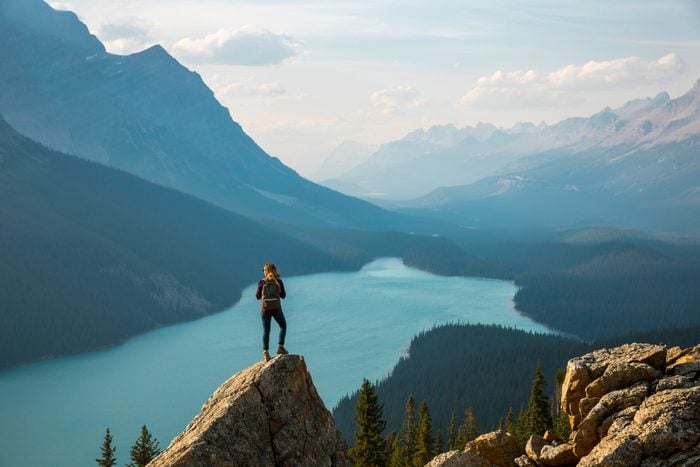
Don’t put off that trip any longer
Our planet is filled with some truly stunning destinations—and they’re likely among the bucket-list trips you’re hoping to take someday. Sadly, some of those spots are slowly disappearing due to climate change and other human-caused issues, including overtourism and industry. “The past eight years were the warmest on record globally, fueled by ever-rising greenhouse gas concentrations and accumulated heat,” according to the World Meteorological Organization. This has caused the ice in Antarctica to melt at an average rate of 150 billion tons per year, and Greenland to lose 270 billion tons per year. As a result, some landscapes will be dramatically altered—and others could be completely underwater in a matter of years, victims of rising sea levels around the world.
Wondering if you should even visit these places, especially if you’re trying to curtail your carbon footprint and live more sustainably? The answer is yes … as long as you travel in a sustainable way. At many places, your tourism dollars can actually fund projects that help preserve or restore these delicate ecosystems. And, of course, it’s important to enjoy our world in all its natural beauty, which will also help you understand why it’s so important to protect it.
So where should you start? We’ve compiled a list of some of the most stunning and at-risk spots around the globe. While some are in far-flung locales, others can be part of an affordable family vacation, so kids can become stewards of the environment too.
Get Reader’s Digest’s Read Up newsletter for more travel, tech, cleaning, humor and fun facts all week long.
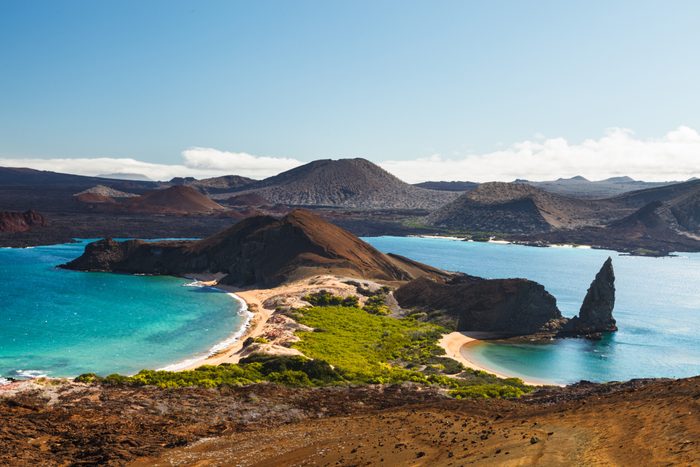
The Galápagos Islands
If experiencing the vast wildlife and gorgeous beaches of the Galápagos Islands is on your bucket list, you’re going to want to book a flight soon. Overfishing and rising ocean temperatures have severely compromised the islands’ ecosystem: Coral reefs are beginning to die, and native animals are threatened by tourists. Conservationists are trying to bring the island back to what it used to be, though. One effort involves releasing iguanas; these animals had gone extinct here due to invasive predators, but they serve a vital role in dispersing seeds in areas without vegetation. And the Ecuadorian government now focuses on ecotourism, closely controlling how many people can visit the islands and how many cruise and tour companies can operate in the national park.
Don’t miss: Swimming with playful sea lions that will twirl and flip as you take a dip in the clear Pacific Ocean.
How to visit: Quasar Expeditions small-ship cruises of 32 people or fewer focus on supporting conservation projects to protect these unique islands, with the core mission of bringing guests to this remote destination while leaving the smallest footprint possible. Quasar is all about sustainability, offering carbon-neutral educational adventures in which guests explore the area in the company of highly trained guides who know how to preserve this delicate and important ecosystem.
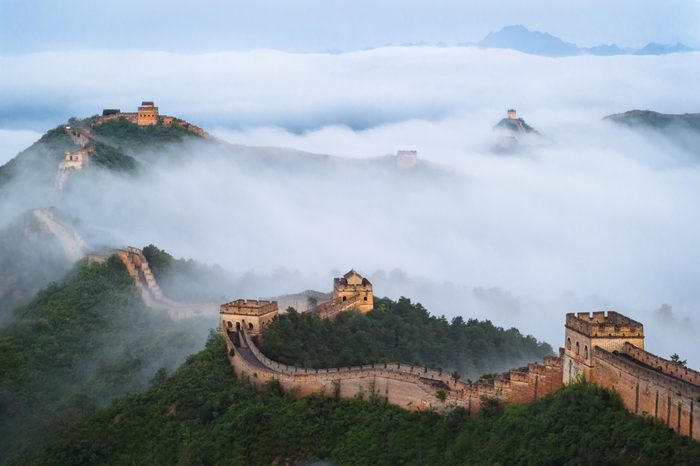
The Great Wall of China
China’s most famous monument stretches more than 13,000 miles in its entirety, but according to Smithsonian Magazine, less than 9% of the Great Wall remains in good condition. Erosion has eaten away at most of the Ming Dynasty portion of the Wall, and although it’s located in one of the most remote places on earth, the Wall has been additionally eroded by tourists who walk on it, locals who pilfer bricks for their own use and graffiti artists who use it as a canvas. If you visit, it’s incredibly important to approach this landmark with extreme care and respect.
Don’t miss: A toboggan ride from the top of the wall down to the bottom.
How to visit: Commune by the Great Wall, part of The Unbound Collection by Hyatt, offers guests a unique experience at one of China’s most celebrated UNESCO World Heritage sites. Located in a picturesque valley and connected by a private path to an unrestored section of the Great Wall, it boasts 175 rooms and suites spread across 36 villas, all with incredible views of the surrounding mountains. While there, enjoy an on-site pool and multiple dining venues, as well as access to the popular Badaling and quieter Shuiguan sections of the Wall.
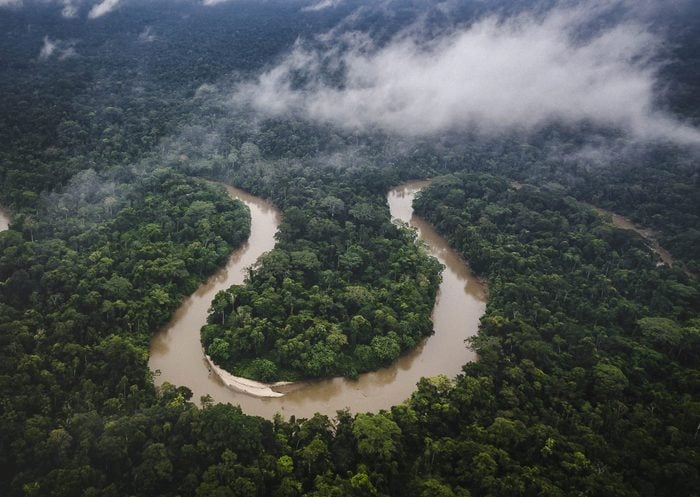
The Amazon Rainforest
The Amazon Rainforest, often referred to as the “lungs of the world” for its dense greenery, is slowly disappearing. Five decades ago, Brazil incentivized its people to colonize the Amazon, chipping away at the lush forest and replacing it with logging yards, cattle enclosures and soy farms. The current president of Brazil believes that the Amazon should be open for business, and since his inauguration in January 2020, the rate of deforestation has grown by a whopping 92%. Plus, increased human activity in the forest and a changing climate have led to devastating forest fires that cause irreversible damage. If something isn’t done, the entire forest could be gone in a few generations, which is why conservation efforts and sustainable tourism are especially important here.
Don’t miss: Keep an eye out for the rare, endemic pink dolphins, one of the unique animals that live only in the Amazon Rainforest.
How to visit: Book a trip with Delfin River Cruises, a company that’s all about low-impact travel and protecting the Amazon. On these luxury small-ship river cruises, naturalist guides bring guests deep into the Amazon to see the river that’s home to one-third of all the world’s recorded animal species, including unique creatures such as the Amazonian jaguar, the pink dolphin and the triangular-headed mata mata turtle.
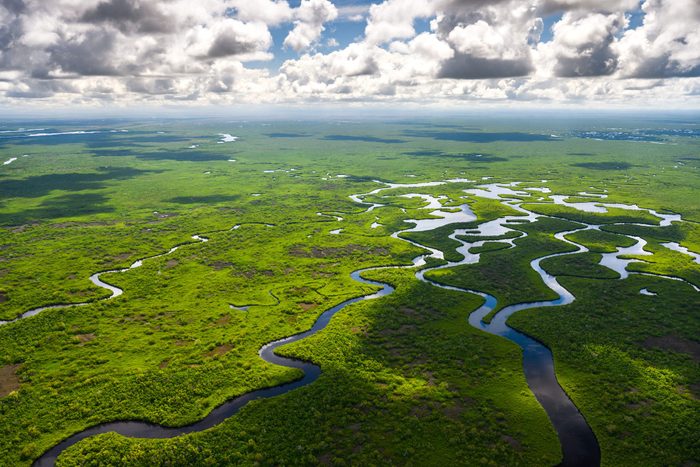
Everglades National Park, Florida
The beautiful and unique wetland wilderness at the southern tip of Florida contains the western hemisphere’s largest mangrove ecosystem and largest continuous stand of sawgrass prairie. It is home to an exceptional variety of wading birds, reptiles and numerous threatened species, such as the Florida panther and manatee. Unfortunately, urban development, manufacturing and agriculture pressures have destroyed more than half the original Everglades, and what remains has been on UNESCO’s List of World Heritage in Danger since 2010.
Don’t miss: Take an airboat tour through the waterways to see the wildlife—including alligators—that live in the Everglades.
How to visit: The Hilton Fort Lauderdale Beach Resort is located about an hour’s drive east of the Everglades, right on the Fort Lauderdale Beach strip, giving guests the ability to enjoy the famed beaches of Florida while also being within driving distance of the park. (There are no hotels in the national park.) The all-suite hotel offers guests their own private terraces with unbeatable intracoastal or oceanfront views.
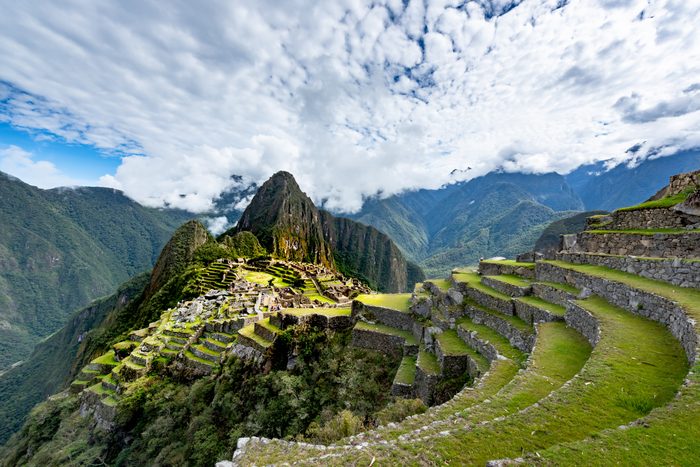
Machu Picchu, Peru
Perched high in the Andes Mountains of Peru, this Incan citadel is one of the new seven wonders of the world. Even though Machu Picchu was abandoned as the Incan empire collapsed in the 16th century, the Spanish invaders never found it due to its remote mountaintop location, and it sat largely undisturbed until it was found by explorers in 1911. Due to its high altitude at 8,000 feet, extreme topography and harsh weather conditions, however, the “Lost City” is at high risk for erosion due to natural disasters. Overtourism is an issue too. It’s estimated that only several hundred people lived here when the city was full, but now, more than 5,000 people visit every single day. Preventive measures are being taken to make sure to site stays intact for as long as possible, though, and much of the money earned through tourism is used to keep the city’s integrity.
Don’t miss: People aren’t the only living creatures at Machu Picchu—you’ll also get to see the llamas that live in the high altitudes at this UNESCO site.
How to visit: Tambo del Inka, a Luxury Collection Resort & Spa, is centrally located in Peru’s Sacred Valley and boasts a private train that goes right to Machu Picchu. The scenic railway features gourmet food served in a dining car, as well as a glass-enclosed panoramic observation bar car, for a luxurious but still eco-friendly two-hour trip. As for the resort, it’s pretty amazing too. In addition to amenities such as an indoor and outdoor pool and a full-service spa, it offers local dining and cooking experiences, plus a wide array of tours, hikes and cultural immersion experiences in the surrounding area.
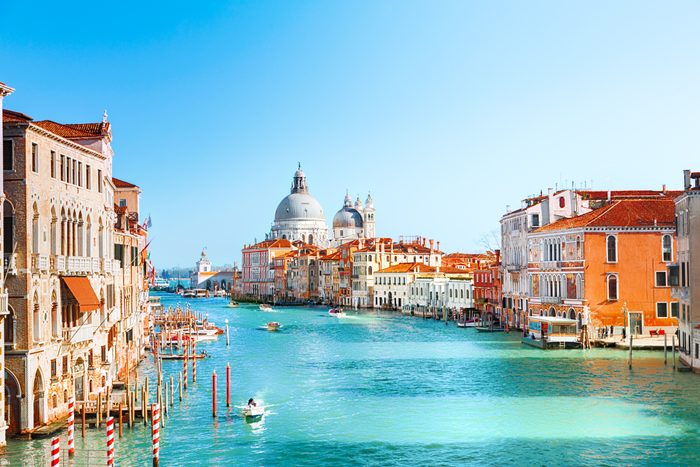
Venice, Italy
If you’ve always dreamed of taking a romantic gondola ride on Venice’s picturesque canals, there’s no time like the present to book that trip. (Though there are certain times of the year that are better to travel to Italy than others.) Due to rising sea levels and natural tectonic processes, the stunning “Floating City” is sinking at a rate of one to two millimeters per year. That translates to more than three inches over the next two decades, and, in a worst-case scenario, the entire city would be underwater by 2100. In 2019, the city had a frightening preview of this with a flood that filled iconic San Marco Square with several feet of water. The Italian government is currently investing billions to try to find a solution that will keep the city from being submerged.
Don’t miss: Take a gondola ride with one of the professional gondoliers (many of whom are part of families that have been boating here for multiple generations) for an up-close view of the narrow canals that weave through the city.
How to visit: Leave the crowds of San Marco Plaza behind, and hop on a water taxi to get to the Hilton Molino Stucky. This hotel is a former flour mill located on the peaceful island of Guidecca, which is just across the canal. Today, the artfully restored property offers 379 spacious rooms, many with canal and city views, plus a popular rooftop pool and cocktail lounge that have expansive vistas of the city. It also boasts the largest spa in Venice.
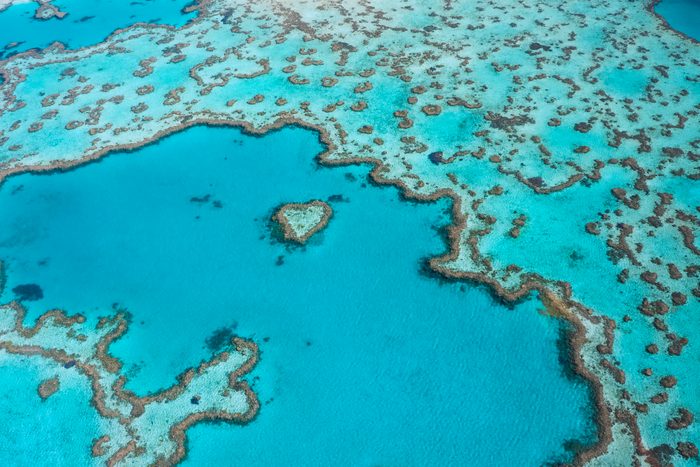
The Great Barrier Reef, Australia
The world’s largest and most breathtaking coral reef, located in Australia off the coast of Queensland, is dying at the hands of humans. Climate change and pollution have led to acidification, extreme weather and crown-of-thorns starfish outbreaks, a major source of coral loss. Spikes in water temperature have also caused large-scale coral-bleaching episodes, causing vast swaths of colorful corals to turn a sickly white. More than half of the reef’s coral cover has disappeared since the 1980s, according to the Australian Institute of Marine Science, and experts say the rest could be lost within the next two decades. However, the Great Barrier Reef is still filled with stunning deep-sea sights within its 1,429-mile ecosystem, and through carefully controlled ecotourism, you can still visit it responsibly.
Don’t miss: Go scuba diving and snorkeling to enjoy close encounters with more than 1,500 species of tropical fish.
How to visit: You can’t go wrong with a stay at the InterContinental Hayman Island Resort, which is positioned right at the heart of the Great Barrier Reef. Surrounded by verdant cliffs, white-sand beaches and celestial-blue sea, the resort’s 182 rooms, suites and villas will immerse you in the spectacular scenery of the area and give you easy access to explore the watery wonders here.
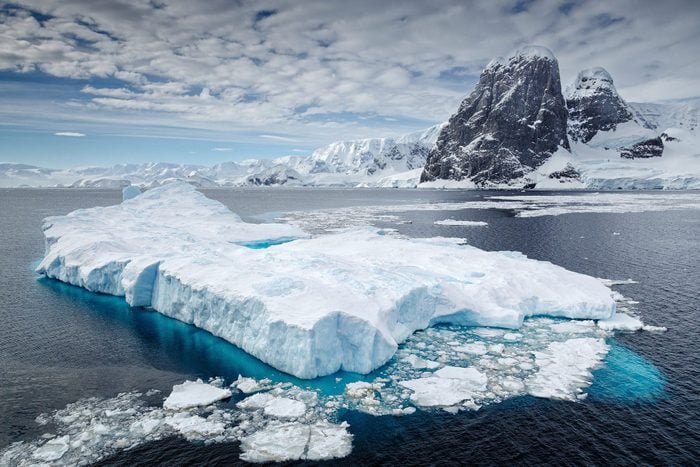
Antarctica
Ready for your next big adventure? During the summer months in the southern hemisphere, the sea ice shrinks, allowing cruise ships access to a vast white wilderness larger than Europe and home to an incredible assortment of species, including penguins, leopard seals and orcas. It’s truly amazing. What’s not so amazing is that the world’s permanent ice caps are on track to shrink by nearly 25% by the end of the century, and most of this will occur in the Antarctic Peninsula, according to a recent study published by Nature. This will irreversibly change the continent’s fragile ecosystem, and the ice shelves will shift and the glaciers will melt. If you want to see the frozen continent the way it currently appears, you’ll need to visit sooner rather than later.
Don’t miss: The thousands of penguins you’ll spot on your trip. Have your camera ready!
How to visit: You’ll need to take a ship to visit icy Antarctica. Special expeditions with Scenic Cruises include multiple landings per day to see the vast penguin rookeries, scientific research stations to better understand life in the harsh climate, and kayaking around the icebergs. This cruise line also offers the opportunity to take in the white continent from a very different perspective: flying above the landscape in one of the ship’s helicopters or diving below the surface in a state-of-the-art submarine. Trust us when we say this is an experience unlike any other—and one you won’t want to miss.
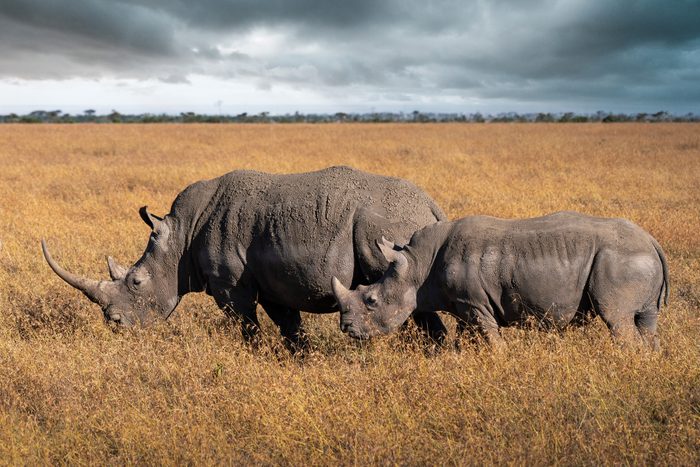
Ol Pejeta Conservancy, Kenya
Kenya’s 90,000-acre wildlife conservancy, situated between the foothills of the Aberdares and Mount Kenya, is home to the only two northern white rhinos left on the entire planet. The conservancy is working to protect these highly endangered creatures. The two rhinos, named Najin and Fatu, live in a 700-acre enclosure that can be visited by guests, says David Katwiwa, a Kenya travel specialist at Audley Travel. Clients interested in learning more about the conservation side of the park and its efforts to safeguard its rhino population can spend time with the rangers and anti-poaching dog unit, even participating in their training.
Don’t miss: The conservancy is also home to an extensive variety of other African animals, including lions, leopards, elephants and Cape buffalo, which, along with rhinos, make up the Big 5 of safari lore.
How to visit: Kicheche Laikipia, a small, friendly camp with luxury tents that overlook a waterhole, puts you in a prime position at the heart of Ol Pejeta Conservatory. During your stay, you’ll get to participate in day and night game drives led by rangers, bush walks and a chance to visit Najin and Fatu. You can also book a stay at the lodge as part of a larger safari with Audley Travel.
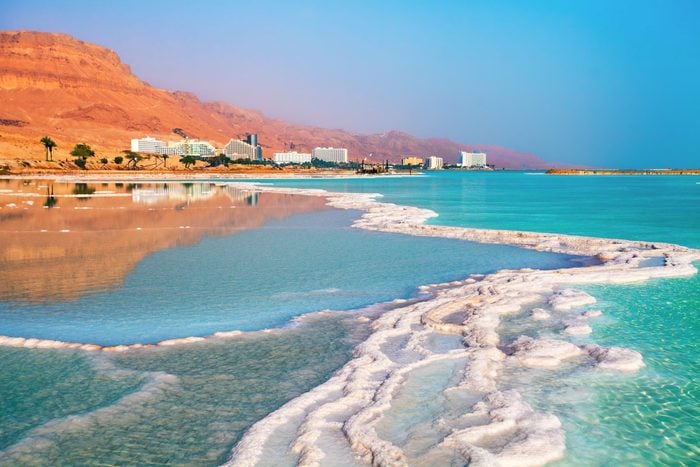
The Dead Sea, Israel
A tourist draw for more than two millennia, this landlocked salt lake between Israel and Jordan is located at the lowest point on earth, nearly 1,400 feet below sea level. The Dead Sea’s other unique feature is the remarkably high salinity of its water, which makes swimming more like floating. The water’s high magnesium content is also said to improve skin hydration, help circulation and soothe skin irritations. Unfortunately, the future of the Dead Sea is less than idyllic. Since 1960, the Dead Sea has lost a third of its surface area due to evaporation from high temperatures and continues to shrink about 3.3 feet per year, according to the environmentalist group EcoPeace Middle East.
Don’t miss: Use the mineral-rich mud for a free facial while you float in the saline waters. Don’t worry—everyone else will be covered in mud too!
How to visit: Book a stay at the Hod Dead Sea Hotel, part of the Herbert Samuel hotel chain. Located in the northern area of Ein Bock, it’s in a prime position right on the shores of the Dead Sea. The hotel offers 205 rooms and modern villas, all with stunning views of both the desert and the Dead Sea.
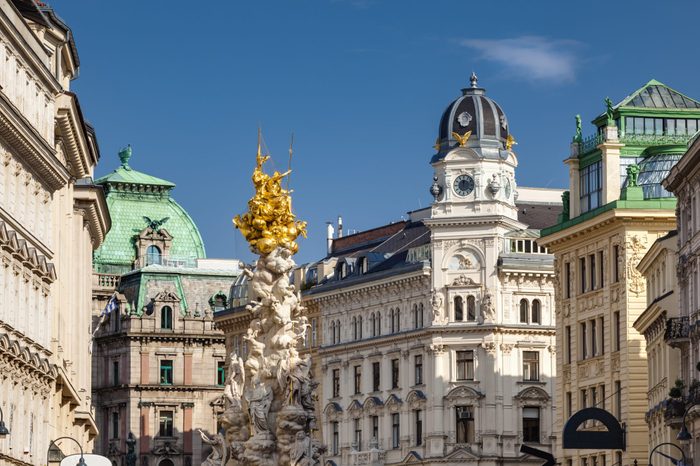
Vienna, Austria
From rococo palaces and baroque castles to famed coffeehouses, world-class museums and labyrinthine alleyways, Vienna’s appeal has endured for millennia. But in 2017, UNESCO added the beautiful historic center of the Austrian capital to its List of World Heritage in Danger due to a boom of high-rise projects that will change the city’s skyline forever. According to UNESCO, the city had been ignoring its warnings that massive modern buildings would negatively affect the city’s medieval and baroque castles and gardens, as well as the late-19th century Ringstrasse. However, groups are fighting the modernization of the city, and UNESCO will reevaluate the city’s “red listing” as early as this year.
Don’t miss: Spend some quiet time enjoying Viennese pastries and coffee in a traditional coffeehouse.
How to visit: Stay at the Harmonie Vienna, part of the BW Premier Collection. This luxury boutique hotel has a perfect “5” rating on Tripadvisor, and it also happens to be part of the Best Western family, so it offers great value. Plus, while the hotel is located in a quiet spot, it’s just a few minutes from the tram and 10 minutes from the city’s beautiful historic center—where you’ll find iconic landmarks such as the Vienna State Opera, the 16th-century St. Stephen’s Cathedral and the Hofburg, the former imperial palace of the Hapsburg family.
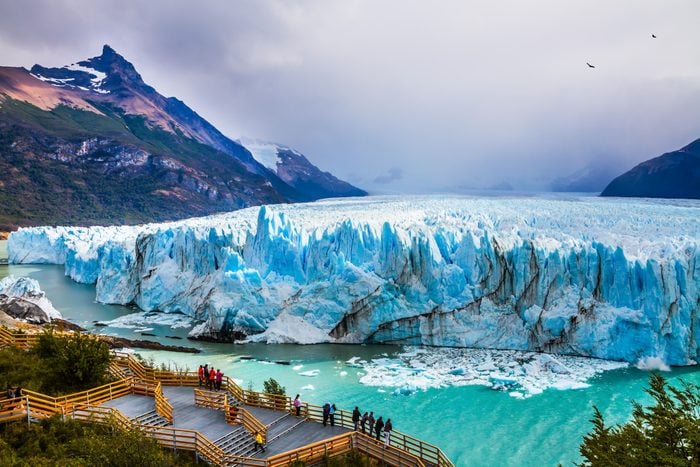
Patagonia
Here’s a fascinating fact for you: The 10 million–acre system of national parks in Patagonia is more than three times the size of Yellowstone and Yosemite combined. For adventure lovers, the sheer amount of nature has a magnetic pull, especially the glaciers and ice that create the otherworldly scenery here. However, much like in Antarctica, the Patagonian ice fields in the Southern Andes range, which straddles Argentina and Chile, are shrinking at an alarmingly fast rate due to global warming. In a 2015 study, scientists from UC Irvine found that Patagonia’s glaciers are receding by up to 6.4 miles per year, one of the highest rates on the planet. While scientists are trying to figure out how to protect both the land and the people in this region, the situation is still dire.
Don’t miss: Kayak on Grey Lake, hike in Bernardo O’Higgins National Park, embark on an ice trek or take a boat ride right up to the glacier walls. All these activities will give you a glimpse of the magnificent Grey, Balmaceda and Serrano Glaciers before it’s too late.
How to visit: The Singular Patagonia was declared a national historical site for its renovation of a post-Victorian cold-storage plant into an eco-friendly, luxury historical escape at the so-called “end of the world” in Chilean Patagonia. The remote property has 57 rooms, a spa, two restaurants and a bar, all boasting amazing views of the Señoret Channel.
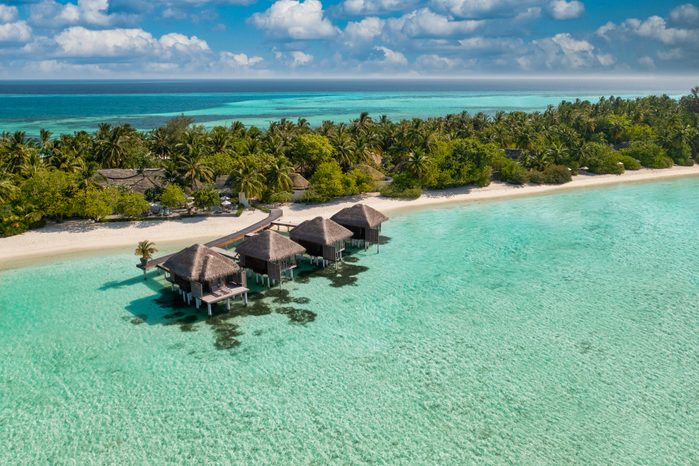
The Maldives
In 2017, a study published in Nature determined that climate change has accelerated the rate at which sea levels are rising. So it stands to reason that the destination most at risk is the lowest-lying country in the world, an island nation comprised of a series of atolls formed from coral in the Indian Ocean. Go now, while the Maldives are still a tropical paradise with year-round temperatures in the low 80s, crystalline waters and beaches that glow in the dark. According to recent data, the islands could be 80% underwater by 2050 if efforts to increase the health and strength of coral reefs around the islands don’t succeed.
Don’t miss: Take full advantage of the clear waters here, which are teeming with rainbows of fish, by snorkeling, diving, surfing or setting sail.
How to visit: Situated within the UNESCO Biosphere of the Baa Atoll, Anantara Kihavah Maldives Villas is surrounded by tropical flora and fauna. This is the spot to truly commune with the sea, with accommodations in overwater villas, an underwater restaurant and sea activities including snorkeling with manta rays and sea turtles. Anantara Kihavah is committed to preserving the island through conservation programs and education, and you can enjoy its orchid and organic gardens, which offer a naturally beautiful and shady alternative to the beach.
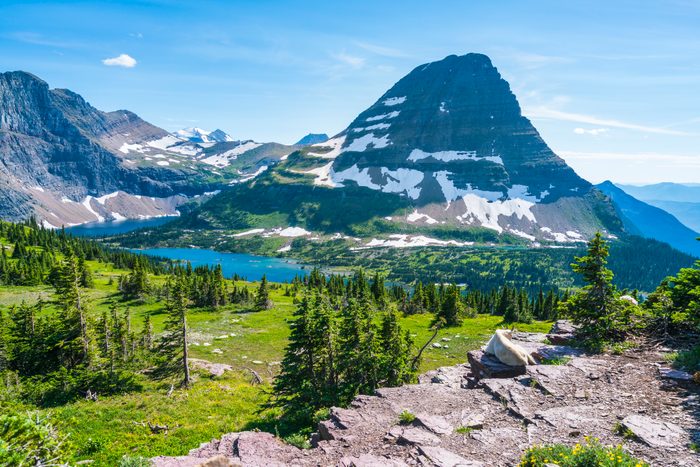
Glacier National Park, Montana
More than 3 million people visited Montana’s Glacier National Park in 2017, making it the busiest year in park history. After a dip in attendance due to the pandemic, numbers of visitors were nearly as high again in 2021. The record-setting attendance was all the more notable given that this pristine park is rapidly losing its eponymous glaciers. A report released by the U.S. Geological Survey found that over the past 50 years, global warming has caused the 26 remaining glaciers in the park to shrink, some by as much as 80%, between 1966 and 2015. There are also significantly fewer glaciers today—there were 150 in 1850. At this rate, scientists predict there will be no ice left here by the end of the century.
Don’t miss: Drive along Going-to-the-Sun Road—it’s known as one of the most beautiful national park drives in the country.
How to visit: The spacious glamping tents with private bathrooms at Under Canvas Glacier let you enjoy the wide open skies near Glacier in a camping atmosphere but without having to bring your own gear or worry about the elements. A wood-pellet stove inside your plush tent, which comes with a king-size bed, will keep you nice and toasty at night, and nightly s’mores around the campfire will give you a delicious taste of traditional camping. And you’ll be just 10 minutes from the park’s west entrance.
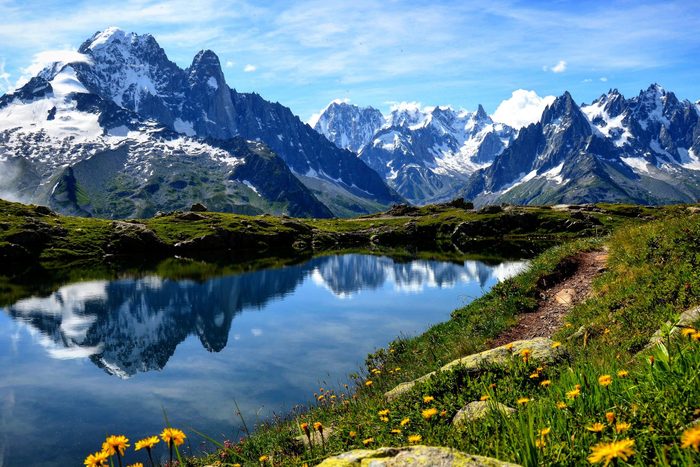
Chamonix, France
The French Alps are known for their impressive snow and steep slopes, which make it a haven for skiers. One main component of the area is the massive Mer de Glace (Sea of Ice) glacier, the largest glacier in France, where visitors can descend into an ice cave to explore the frozen heart of the Alps. Due to global warming, however, the glacier is melting, with scientists reporting losses of almost 4 inches of thickness per day last summer. According to reports, the extreme heat wave during June 2022 combined with the lack of precipitation contributed to accelerated melting.
Don’t miss: Make sure to ride the bright-red cog train to the top of the Mer de Glace.
How to visit: The Heliopic Hotel and Spa is nestled at the foot of Aiguille du Midi in Chamonix. A stay here will get you transfers to the glacier and the mountain, as well as ski passes. You’ll also get to relax in the outdoor pool and hot tub while taking in views of the Alps and stunning surrounding area.
Additional reporting by Suzanne Rowan Kelleher.
Sources:
- World Meteorological Organization: “Past eight years confirmed to be the eight warmest on record”
- NASA: “Sea Level”
- Booking.com: “Sustainable Travel Report 2022”
